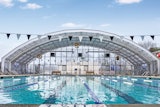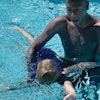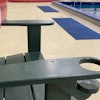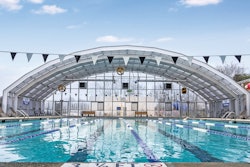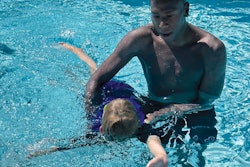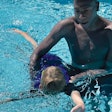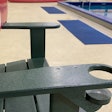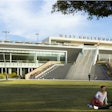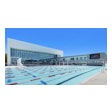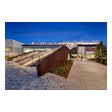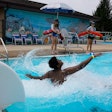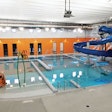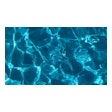![Shawnee Mission School District Aquatic Center [Photo by Matt Kocourek Photography]](https://img.athleticbusiness.com/files/base/abmedia/all/image/2020/09/ab.compPools920_feat.png?auto=format%2Ccompress&q=70&w=400)
It takes much more than a pool of water to put on a competitive swimming event.
There are moving parts at every level of competition — from local club teams to high schools to colleges and on up to the Olympics. While every pool operator is working with different programming and funding capabilities, competition pool options have expanded over the years to allow operators to find what's best for their facility. There's no one-size-fits-all solution. Therefore, the expanding options dictate that building a pool starts with the planning phase.
Justin Caron, principal and CEO of Aquatic Design Group, says that whenever his group gets a lead on a new pool, they sit down with the operators and find out exactly what they're looking for with their facility.
"If someone were to say to me, 'We want a really good competitive pool,' I'd say, 'Well, let's try to understand your program better,' " says Caron, a former NCAA All-American swimmer at Auburn University. "Are we talking about swimming? Are we talking about water polo? Are we talking about diving? Are we talking about artistic swimming? Are we talking about a combination? Is it a standalone competitive facility? Is it going to be used by high schools? Is it going to be used by club teams? Is it going to be used by college teams? Professional teams? What are your seasons? Do you want to be able to host meets? How many kids are on the team?"
The answers to those questions vary greatly depending on a number of factors, including the level of competition, climate, budget and population.
"Competition pools can go anywhere from a six-lane, 25-yard pool with a shallow end and deep end to an all-deep, 65-meter pool with multiple removable bulkheads," Caron says. "It's really trying to understand the programming before you can define what that competitive pool is."
According to Caron, a trend at the Division I college level has been to build a large competition pool that is also fit for use by intramural teams, clubs and any other university programming. Moving every body of water within one holistic center allows the facility to be shared on campus and, as Caron says, "allows for some synergies with operations, deliveries, maintenance and personnel."

Building for speed
It all starts in the pool. The water — and the athletes' ability to move through it — remains the most important part of any competitive aquatics event. Traditional competition pools are 25 or 50 yards long, with six, eight or 10 lanes for racing. However, every aspect of the pool itself — size, depth and wave action — makes a difference when swimmers seek fast times.
"Competitive swimming is all about speed, so we've really seen over the years an effort to make those facilities as fast as possible," says Juliene Hefter, executive director of the Association of Aquatic Professionals. "It sounds funny when you say that a pool can be fast, but how the pool is built and designed can make a pool very fast. If you have the ability to have three lane lines between each lane, that's going to make it faster because you have less wave action. If you have the appropriate gutter systems, where the water flies into the gutter and doesn't come back at the swimmers, that's going to make it faster. And deeper water makes it faster."
The details matter. USA Swimming requires that water temperature is between 77 and 82.4 degrees Fahrenheit for competition. In indoor facilities, the air temperature must be at least 76 degrees Fahrenheit within 8 feet above deck level, while the relative humidity is about 60 percent and air velocity about 25 feet per minute.

Separating spaces
Larger pools require a way to separate the spaces in order to ensure each area is suitable for competition. That's where bulkheads come in. These structures, which are typically movable, are used to separate sections of pools to allow simultaneous events to go on without impacting each other.
If a pool has a water polo area, diving well or family-swim area, bulkheads can be crucial in keeping an adjacent swim course wave-free for racing.
"Typically, we see the bulkheads that are put in place and move back and forth," says Hefter. "It can actually get installed in a facility that's current or a new facility. You might need an area not just for competitive swimming, but you could have competitive swimming on one side and swim lessons on the other."
Water polo is becoming much more prominent and, in certain areas of the United States, pools are being built with that sport in mind. Water polo is played in about the same depth of water as swimming, in order to limit waves and ensure no players can touch the bottom of the pool. However, the pool must increase in size if it's going to hold water polo events.
"With floating cage water polo, if you're doing a 25-meter floating cage course, you have that same 25-meter dimension, but then you also have to have room for the cages and room behind the cages, so you take that 82-foot dimension and now that essentially becomes 94 feet," Caron says. "A lot of codes in states require some shallow water for somebody who may not be comfortable in water, so that becomes a 33- or 34-meter by 25-yard pool in order to accommodate that floating cage water polo pool."
![Piedmont Wellness Center [Photo by Nick Merrick © Hall+Merrick Photographers]](https://img.athleticbusiness.com/files/base/abmedia/all/image/2020/09/ab.pools920c.png?auto=format%2Ccompress&fit=max&q=70&w=400) Piedmont Wellness Center [Photo by Nick Merrick © Hall+Merrick Photographers]
Piedmont Wellness Center [Photo by Nick Merrick © Hall+Merrick Photographers]
Guiding the swimmer
While bulkheads are used to separate portions of a competition pool, lane lines — numbered right to left when the swimmers are facing the water — separate the competitors.
USA Swimming requires a minimum lane width of 2.5 meters from center line to center line of the lane dividers. The lanes are made clear by floating lane dividers — between five centimeters and 15 centimeters in diameter — that extend the length of the course and attach to the end walls. Distinctive colors are placed 15 meters from each end wall to keep the swimmers abreast of where they are in the water.
The lane lines correspond with bottom lane markers that are a dark, contrasting color — typically black — to keep swimmers on course when looking downward. The bottom markers run the length of the course uninterrupted, with an end cross line. The bottom markers match up with non-slip targets, regularly in the shape of a cross, that are located at the center of each lane on each end wall. USA swimming requires that the targets extend at least one meter below the level of the water's surface.
Triangular pennants strung along each lane allow swimmers to stay on track while on their back during the backstroke, individual medley and medley relay events. The pennants are located between 1.8 meters and 2.5 meters above the surface of the water for both long and short courses.
Competitive swim events also require the basics — sound and sight. Loudspeakers and sound systems inform swimmers of the order of events, while USA Swimming requires a minimum of 100-foot candle illumination level at the surface of the water.
Planning for uncertaintyCompetitive swimming is currently taking place in unique locations as the pandemic has canceled events and forced some athletes to work out at home. Trevor Tiffany, a chairman of Myrtha Pools and former executive for Swimming Canada, says that companies and athletes are working to find new ways for athletes to train away from their regular pools. "There's no excuse if you've got access to water not to be able to create your own environment to train in during the next crisis or the extended crisis if it carries on," Tiffany said during a Myrtha Facebook Live earlier this summer. "There are many opportunities, and individuals have made their own way to train, like backyard pools. "Putting a pool in a container that can easily be moved to another location. If you combine that container with an endless pool situation, then you have a nice opportunity to keep swimming. These are real good considerations for swim clubs, for coaches. It's really a suitable method when you can't get in the pool. It's also good for under water videos, good for training, good for stroke technique and so on." |
Seating a crowd
The sound system and lights are also beneficial for the crowd. Whether accommodating parents at local meets or fans at the Olympics, any operator building a competitive facility needs to take those crowds into account — ensuring that there is enough deck space to accommodate every swimmer, official, timer and fan at the event.
"Where are you going to put those swimmers?" Hefter says. "You either have to have them on the deck of the pool, in bleachers, or you have to have them in a nearby staging area. You also have to take into consideration all the people who are going to be watching. You're going to have people coming to watch these swim meets, so where are you going to put them? You have to look at how comfortable they're going to be. If the bleachers are way up above, how's the air circulation? Is it going to be cool enough up there?
"How is your locker room set up? Making sure it's large enough, having showers, the appropriate number of restrooms, ADA requirements for locker rooms and restroom areas. For the people who are observing meets, how are they going to get up to that area if they're in a wheelchair or if they need some additional help. Also looking at competitive pools, not just in the area of competition, but also for safety. Making sure you have the appropriate areas for your lifeguard stands. How are your lifeguards going to be able to observe and enforce rules when you have that many people on a pool deck. How are they going to keep them safe?"
Those factors can look significantly different between indoor and outdoor facilities.
"The pool itself doesn't really change. The dimensions of the pool are the dimensions of the pool," Caron says of the difference when constructing an outdoor facility. "There are some things that might be slightly different in the mechanical room with regards to setup, but the big differences you see there are on the dry side. For an indoor pool, you'd typically stack that space on top of other programs to save space. Say we're talking about an outdoor pool at $250 per square foot for the pool and $40 per square foot for the surrounding deck. If you're doing that indoors, you've got the same but then you've got a $500-per-square-foot building that surrounds it, so you condense the deck a little bit by stacking things."
![The St. James [Photo by Garrett Roland]](https://img.athleticbusiness.com/files/base/abmedia/all/image/2020/09/ab.pools920d.png?auto=format%2Ccompress&fit=max&q=70&w=400) The St. James [Photo by Garrett Roland]
The St. James [Photo by Garrett Roland]
Diving in Once all those considerations have been addressed, the competition can commence.
It begins on the starting platforms, which are required by USA Swimming to be between .5 meters and .85 meters above the surface of the water for short course and long course pools. The non-slip platforms must have a front edge flush with the end of the pool and have no more than 10 degrees of slope.
Backstroke platform grips must be between 12 to 24 inches above the surface of the water, and parallel to the face of the end wall. Backstroke ledges are a minimum of 65 centimeters in width, 8 centimeters in height and are adjustable to 4 centimeters above or below water level.
"Backstroke ledges can be used as a ledge to put your feet and toes," Doug Cook, chairman of the board at Counsilman-Hunsaker, says of the developments in the starting area. "That's something that's new, and after you start it snaps back up into place in the starting block."
USA Swimming also requires that the water depth upon entry "for teaching all racing starts, prior to certification, in any setting from any height starting blocks, from backstroke ledges or from the deck shall be 6 feet measured for a distance of 3 feet 3-1/2 inches to 16 feet 5 inches from the end wall."
![Boston College, Connell Recreation Center [Photo courtesy of CanonnDesign]](https://img.athleticbusiness.com/files/base/abmedia/all/image/2020/09/ab.pools920e.png?auto=format%2Ccompress&fit=max&q=70&w=400) Boston College, Connell Recreation Center [Photo courtesy of CanonnDesign]
Boston College, Connell Recreation Center [Photo courtesy of CanonnDesign]
Keeping time
Competitive pool technology has made no bigger advancements than in timing systems.
After years of handheld timing susceptible to human error, many competitive events are now equipped with automated touchpads that have taken the minutiae of swimming to another level.
"We have automatic touchpads built into the wall, so somebody hits the wall instead of relying on a person with a stopwatch," Hefter says.
USA Swimming recommends that touchpads are placed in the center of each lane and at least 2 feet underneath the surface of the water. The "panels shall stop the timing system instantaneously by a light hand touch anywhere on the flat surface facing the racing course and the upper edge shall not be activated by water turbulence."
There have also been vast improvements in where those times are displayed.
"Timing systems and scoreboards have certainly evolved over the last 20 years," Caron says. "A good videoboard even 10 years ago would be three times the cost of an average board today. Now, a $100,000 scoreboard is going to be a really nice scoreboard capable of video quality that doesn't look pixelated when you're standing 10 feet away from it. Not that $100,000 is inexpensive, but that's within a lot of fundraising budgets and an achievable goal."
Cooling down
Competitive aquatics events require athletes to warm up and cool down. Many events hold these periods in the regular lanes during breaks in the action, while other facilities have designated bodies of water in which swimmers can warm up or cool down when necessary.
"If you can have that, you want to have it," Hefter says of separate warmup areas. "A lot of people will use the diving well area if it's separate from the pool. Or, if you have a larger pool and you can block it off with a bulkhead, then you can have cool down in that area because that blocks the waves. In a perfect world, we'd all have those areas."
Accessibility
Competition pools serve many different levels of swimmers. Some of the high-tech systems in place at the Olympics likely aren't necessary for youth swimmers, while Masters Swimming or Special Olympics programs may have requirements that aren't needed at Division I colleges.
"Make sure everything is ADA-accessible and everyone can have that same experience participating in a swim meet," Hefter says. "Because we're not just talking about kids and younger people. There are Masters swimmers in their 90s. And when we've got a competition pool, we're probably not going to be using it just for competition, unless you're a swim school that only does that. Most of the time you need to look at other avenues to bring in revenue — swim lessons, events, pool programs from log rolling to ninja cross systems — all those different opportunities that we have. There are so many out there to make it fabulous."
This article originally appeared in the September 2020 issue of Athletic Business with the title "Competition pool options, technology expanding." Athletic Business is a free magazine for professionals in the athletic, fitness and recreation industry. Click here to subscribe.










